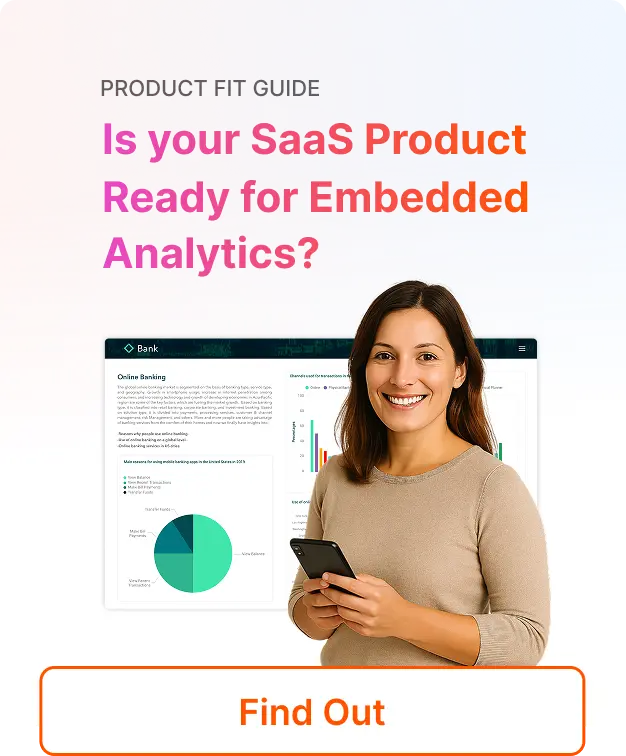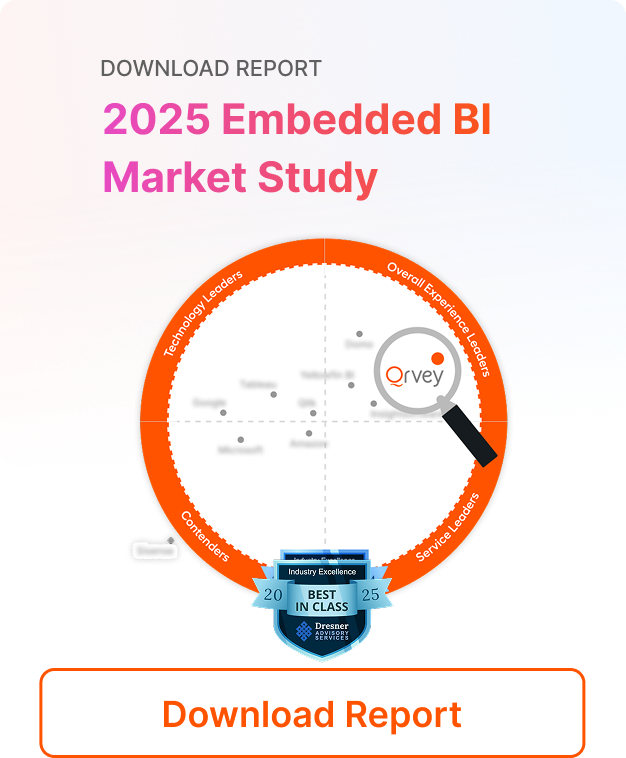
⚡Key Takeaway
- Qrvey — Best for SaaS products that need true multi-tenant, API-first embedded analytics, automation, and white-label control.
- Amazon QuickSight — Best for AWS-centric teams that want serverless scale and pay-per-session economics for external users.
- Microsoft Power BI — Best if you’re deep in Microsoft 365/Azure, need self-service plus robust embedded options.
- Tableau — Best for premium visual analytics with extensive embedded tooling and web authoring in-app.
- ThoughtSpot — Best for AI-/search-driven analytics and low-code embedding with modern SDKs.
Searching for Metabase alternatives because you’ve hit limits with embedding, white-labeling, or scale? Here are the five best options for embedded analytics—with who they’re best for, standout capabilities, and current pricing at a glance. Then we’ll go deeper on each tool (extra detail on Qrvey), and close with when to switch from Metabase.
Fast comparison: Metabase alternatives for embedded analytics
| Name | Best for | Stand-out feature | Price starting point* |
| Qrvey | SaaS products needing multi-tenant embedded analytics | Cloud-native, API-first, automation + white-label | Flat-rate pricing featuring unlimited users, dashboards, instances, data. Request pricing. |
| Amazon QuickSight | Apps/products on AWS needing serverless scale | Pay-per-session and capacity options for embedding | Authors from $18/user/mo (annual); Readers from $3/user/mo; $0.30/session |
| Microsoft Power BI | Microsoft-centric orgs/products with self-service + embed | Mature embedded patterns (“embed for your customers”) | Pro $14/user/mo; PPU $24/user/mo (from Apr 1, 2025) |
| Tableau | Enterprise-grade visual analytics + embedded | Embedding API + Embedded Web Authoring | Viewer from $15–$35; Explorer from $42–$70; Creator from $70–$75 (annual) |
| ThoughtSpot | AI/search-first analytics and modern embedding | Visual Embed SDK + agentic AI (Spotter) | Starts as low as $50/user/mo (annual) + usage |
*Pricing can vary by edition, commitment, and region. Always confirm vendor pages.
Qrvey
Qrvey is purpose-built for software companies that need to ship analytics inside their products with multi-tenant isolation, API-first integration, no-code automation, and full white-label control. It’s cloud-native end-to-end, so teams avoid the overhead of stitching third-party BI to app experiences, and instead deliver embedded analytics that feel truly native.
Key features
- True multi-tenant analytics
Isolate tenant data with row/column controls and tenancy-aware assets, so every customer sees only their data—without complex workarounds.
Learn more: Multi-tenant analytics. - API-first embedding & white-label
Deeply customize layout, theming, and UX while orchestrating analytics via REST APIs and SDKs across your application lifecycle.
Learn more: Embedded analytics platform · Embedded data visualization. - Automation & no-code workflows
Automate data collection, transformations, scheduling, and alerts—reducing manual ops and increasing reliability across tenants.
Learn more: No-code analytics platform. - Cloud-native scale + GenAI
Built for elastic scale with options to add generative experiences safely where they add value.
Learn more: Cloud-native analytics platform · GenAI analytics platform.
Pricing
| Plan | Price | Notes |
| Flat-rate | Request pricing | Unlimited users, dashboards, instances, data, and connections.Tailored to product scale, embedding depth, and tenancy needs |
Where Qrvey shines
- Deep embedding: API-first + white-label makes analytics feel native in your product.
- Multi-tenancy by design: Strong isolation and governance for customer-facing analytics.
- Operational efficiency: No-code automation + cloud-native architecture reduce overhead.
Where Qrvey falls short
- Overkill for simple BI: Smaller teams needing only ad-hoc internal dashboards may prefer a lighter tool.
Customer feedback
Public reviews consistently highlight fast embedding, tenant controls, and responsive support; some teams note that initial configuration is a project (but worth the long-term maintainability).
Who Qrvey is best for
- SaaS/product teams that need scalable, white-labeled, multi-tenant embedded analytics for their end users.
Spotlight on Why SaaS Companies Choose Qrvey’s Embedded Analytics Platform
Qrvey is the embedded analytics platform designed specifically for SaaS companies. The platform was built for multitenancy from day one so there are no head-scratching, keyboard-smashing workarounds to get multi-tenant security stood up. But that’s just one reason why SaaS companies select Qrvey’s tech, here are several more:
Self-service analytics – Let customers build dashboards and workflows themselves, reducing support needs and speeding value.
Embedded & Customizable – Embed and tailor every analytics component to match your product’s UI and branding.
Built-in Data Engine – Analyze complex, large-scale data—no external warehouse or third-party tools needed.
Multi-tenant architecture – Secure, scalable tenant isolation and customization—no workarounds or compromises required.
Deployed in your cloud – Deploy natively in AWS, Azure, or GCP (Coming Soon!) for full control over data, security, and compliance.
Amazon QuickSight
QuickSight is AWS’s serverless BI—popular for embedding in apps where you need to scale to hundreds of thousands of users with minimal infrastructure. For external users, you can choose per-user or pay-per-session pricing, plus capacity packs for large embedded scenarios.
Key features
- Serverless at scale: Auto-scales without servers to manage; SPICE accelerates performance on large data.
- Flexible embedding: Embed visuals, dashboards, NLQ (Q), or even the authoring console within your app.
- Usage-aligned economics: Authors from $18/user/mo (annual), Readers from $3/user/mo, or $0.30 per 30-min session.
Pricing
| Role / Mode | Starting price | Notes |
| Author | $18/user/mo (annual) | $24 monthly option; “Pro” adds GenAI features |
| Reader | $3/user/mo | Reader Pro $20/user/mo (GenAI features) |
| Pay-per-session | $0.30/session | Capacity packs lower unit rates; ideal for embedding |
Where QuickSight shines
- AWS alignment: Integrates cleanly with IAM, VPC, Lake Formation, and more.
- Massive scale & cost control: Serverless + session pricing fits spiky external usage.
- End-to-end embedding: From visuals to full authoring, including NLQ (Q).
Where QuickSight falls short
- UX polish: Visual customization is improving but still less flexible than premium viz tools for pixel-perfect UI.
- Non-AWS stacks: Best when your app and data are already on AWS.
Who QuickSight is best for
- AWS-centric products needing serverless embedded analytics and usage-based economics.
See a comparison of QuickSight and Qrvey.
Microsoft Power BI
Power BI is a top choice for Microsoft 365/Azure shops that want strong self-service plus mature embedding patterns (embed for your customers vs. for your organization). In 2026, Pro is $14/user/mo and PPU is $24/user/mo; Fabric capacities replace legacy Premium capacity SKUs.
Key features
- Self-service + governance: Broad connectors, dataflows, and robust workspace controls.
- Embedded analytics patterns: Clear guidance and SDKs for app-owns-data and user-owns-data scenarios.
- Authoring APIs in embed: Programmatically add/change visuals and author reports in embedded contexts.
Pricing
| License / Capacity | Starting price | Notes |
| Pro | $14/user/mo | Share & collaborate; required for many publish/share tasks |
| Premium Per User (PPU) | $24/user/mo | Larger models, higher refresh, advanced features |
| Fabric capacity (F-SKUs) | Varies | Successor to Premium capacity (P-SKUs) |
Where Power BI shines
- Microsoft ecosystem: Smooth with Azure AD, Teams, Excel, and Fabric.
- Embedded maturity: Extensive docs, SDKs, and patterns for multi-tenant apps.
Where Power BI falls short
- Capacity planning: For heavy external embedding, capacity sizing and governance add complexity.
- Theming/white-label: Good branding options, but not as seamless as purpose-built white-label analytics.
Who Power BI is best for
- Microsoft-aligned teams building embedded and self-service side-by-side.
See a comparison of Power BI and Qrvey.
Tableau
Tableau is synonymous with best-in-class data visualization and offers robust Embedded Analytics with an Embedding API and Embedded Web Authoring so users can create/edit in your app. Pricing differs by edition/role; broadly, Viewer from $15–$35, Explorer from $42–$70, Creator from $70–$75 billed annually.
Key features
- Premium visuals & exploration: Industry-leading dashboard interactivity.
- Embedded Web Authoring: Bring the authoring canvas into your application.
- Developer tooling: Embedding API v3, REST APIs, Playground, and usage-based licensing options.
Pricing
| Role | Typical starting price | Notes |
| Viewer | $15–$35/user/mo | Varies by edition; billed annually |
| Explorer | $42–$70/user/mo | Varies by edition; billed annually |
| Creator | $70–$75/user/mo | Includes Desktop + Prep; annually |
Where Tableau shines
- Visual excellence: Deep interactivity and rich design options.
- Embedding flexibility: Mature APIs and embedded authoring speed up self-service.
Where Tableau falls short
- Cost at scale: Viewer/Explorer licensing adds up for large external audiences.
- Multi-tenant app fit: Achievable, but more assembly vs. tools purpose-built for SaaS embedding.
Who Tableau is best for
- Product and data teams that prioritize premium visual UX and embedded self-service.
See a comparison of Tableau and Qrvey.
ThoughtSpot
ThoughtSpot emphasizes search- and AI-driven analytics with modern embedding (Visual Embed SDK, low-code starters) and a growing set of agentic AI capabilities (“Spotter”). Plans include per-user and usage pricing; developer tier is free for one year for embedding.
Key features
- Search & AI at the core: NLQ, automated insights, and agentic assistants.
- Modern embedding: SDK + REST; embed search bars, Liveboards, or the full app.
- Low-code developer experience: Developer Playground and quick-start guides.
Pricing
| Edition / Model | Indicative starting point | Notes |
| Essentials / Pro / Enterprise | From as low as $50/user/mo (annual); $0.10 per query for some editions | Developer edition free 1 year; embedded packaging available |
Where ThoughtSpot shines
- Time-to-value: Low-code embedding + strong search UX.
- AI-assisted analysis: From guided insights to agentic workflows.
Where ThoughtSpot falls short
- Cost predictability: Per-query/user models demand monitoring in high-traffic apps.
- Traditional BI workflows: Less focus on classic semantic modeling vs. search-first approach.
Who ThoughtSpot is best for
- Teams prioritizing AI/search UX and rapid embedded rollout.
See a comparison of ThoughtSpot Embedded and Qrvey.
Reasons to consider an alternative to Metabase
You might love Metabase for internal BI, but embedded product scenarios often demand stronger white-label, multi-tenant, and scale controls with predictable pricing. Here are the recurring triggers for switching:
1) Interactive embedding & white-label require higher tiers
Metabase’s interactive embedding (the kind you need for multi-tenant self-service) and advanced white-label options are available only on Pro/Enterprise plans—meaning many app teams must upgrade before they can truly embed.
How Qrvey helps: API-first embedding and white-label are core, not an add-on.
2) Cloud plan limitations and timeouts
On Metabase Cloud, there are platform limits (e.g., 10-minute query timeouts, limited email customization, and no access to the application database), which can impact heavier embedded use cases and brand control.
How Qrvey helps: Cloud-native deployment with no-code automation and flexible customization.
3) Scaling multi-tenant SaaS is complex
While Metabase supports multi-tenant patterns on Pro/Enterprise, achieving frictionless tenancy isolation and lifecycle management can take engineering lift compared with platforms built for multi-tenancy from day one.
How Qrvey helps: Multi-tenancy is at the core of Qrvey.
4) Total cost and governance at external scale
As external users grow, you may need a usage-aligned model (e.g., pay-per-session) or serverless scale, or you may want stronger governance APIs for embedding at very large tenant counts—areas where alternatives shine.
How Qrvey helps: Flat-rate pricing aligned to product scale, and governance designed for embedded use.
Choose Qrvey as Your Metabase Alternative for Embedded Analytics
If your priority is native-feeling analytics inside your product—with multi-tenant isolation, white-label, and automation—Qrvey is the most direct path. It’s designed for product teams, not just analysts, so you can deliver governed, scalable analytics that match your UI and grow with your customer base.

Natan brings over 20 years of experience helping product teams deliver high-performing embedded analytics experiences to their customers. Prior to Qrvey, he led the Client Technical Services and Support organizations at Logi Analytics, where he guided companies through complex analytics integrations. Today, Natan partners closely with Qrvey customers to evolve their analytics roadmaps, identifying enhancements that unlock new value and drive revenue growth.
Popular Posts
Why is Multi-Tenant Analytics So Hard?
BLOG
Creating performant, secure, and scalable multi-tenant analytics requires overcoming steep engineering challenges that stretch the limits of...
How We Define Embedded Analytics
BLOG
Embedded analytics comes in many forms, but at Qrvey we focus exclusively on embedded analytics for SaaS applications. Discover the differences here...
White Labeling Your Analytics for Success
BLOG
When using third party analytics software you want it to blend in seamlessly to your application. Learn more on how and why this is important for user experience.








